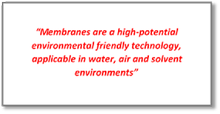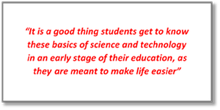 Solvent resistant nanofiltration (SRNF) is a useful tool for separations in organic media, such as the removal of impurities from used solvents, recycling of solvents, or the recovery of products from reaction mixtures in chemical, petrochemical and pharmaceutical industries. ‘Pressure driven membrane processes may prove as an energy friendly alternative to recover impurities from solvents,’ Cheryl Tanardi says. ‘For this end preparing highly selective and chemically stable membranes is required. This thesis deals with the preparation of nanofiltration membranes through organic grafting of ceramic substrates. For these kinds of applications, continuous exposure to organic solvents is expected, giving a need for robust membranes.’
Solvent resistant nanofiltration (SRNF) is a useful tool for separations in organic media, such as the removal of impurities from used solvents, recycling of solvents, or the recovery of products from reaction mixtures in chemical, petrochemical and pharmaceutical industries. ‘Pressure driven membrane processes may prove as an energy friendly alternative to recover impurities from solvents,’ Cheryl Tanardi says. ‘For this end preparing highly selective and chemically stable membranes is required. This thesis deals with the preparation of nanofiltration membranes through organic grafting of ceramic substrates. For these kinds of applications, continuous exposure to organic solvents is expected, giving a need for robust membranes.’

In her PhD work Cheryl fabricated and characterized ceramic membranes prepared by means of grafting of organic molecules inside the pores of these membranes. Integrating pore size and surface wettability/functionality into one single fabrication step is sought for here.
‘This is a difficult process,’ Cheryl says. ‘Only a limited amount of pore sizes are available at the moment. One would wish for all thinkable sizes to be producible. New ideas are welcomed in this thesis research, in which multiple disciplines are combined: materials science, process technology, mathematics and chemical expertise.’
Two-way

In order to create a suitable membrane, Cheryl advocates a two-way working scheme: ‘In my approach I alternate outcomes from materials studies into its performance under application conditions, and use the performance data to better formulate the next membrane. I also model the transport behavior of the membranes. This practical approach suits me well, as I was involved in fabrication and equipment design already, in an industrial setting. During this PhD project I learned how to design and fabricate the actual membranes from a materials point of perspective. The solvent and solute transport mechanisms of these membranes are not described well in literature yet. I was interested in this, as membranes are a high-potential environmental friendly technology, applicable in water, air and solvent environments.’
Education

Cheryl collaborated with university departments in Twente, Montpellier and Leuven, as her project was part of a joined European Erasmus project. As member of the Inorganic Membrane Group, she attended the annual Mesa+ Days and several monthly lectures to see on what topical projects other researchers were working on. Cheryl plans to use her academic skills and knowledge of scientific methodologies for educational purposes in future.

Cheryl: ‘I learned the basics of how science is used. It is a good thing students get to know these basics in an early stage of their education, as science and technology are meant to make life easier. Modeling techniques can contribute considerably to gaining better and more efficient R&D results. Starting my own company, presenting tailor-made education modules for students, very much appeals to me. In my opinion scientific methods used at universities should be open and available to everyone.’
